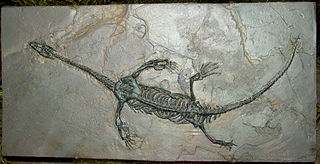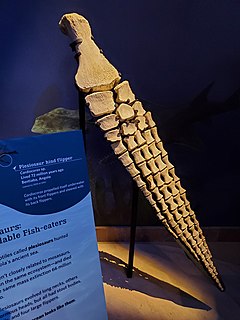Related Research Articles
The human skeleton is the internal framework of the human body. It is composed of around 270 bones at birth – this total decreases to around 206 bones by adulthood after some bones get fused together. The bone mass in the skeleton makes up about 14% of the total body weight and reaches maximum density around age 21. The human skeleton can be divided into the axial skeleton and the appendicular skeleton. The axial skeleton is formed by the vertebral column, the rib cage, the skull and other associated bones. The appendicular skeleton, which is attached to the axial skeleton, is formed by the shoulder girdle, the pelvic girdle and the bones of the upper and lower limbs.

The acetabulum, also called the cotyloid cavity, is a concave surface of the pelvis. The head of the femur meets with the pelvis at the acetabulum, forming the hip joint.

Acanthostega is an extinct genus of stem-tetrapod, among the first vertebrate animals to have recognizable limbs. It appeared in the late Devonian period about 365 million years ago, and was anatomically intermediate between lobe-finned fishes and those that were fully capable of coming onto land.

Jeholodens was a primitive mammal belonging to the order Eutriconodonta, and which lived in present-day China during the Middle Cretaceous about 125 million years ago.

Patagosaurus is an extinct genus of eusauropod dinosaur from the Middle-Late Toarcian of Patagonia, Argentina. It was first found in deposits of the Cañadón Asfalto Formation, which date to around 179 to 177 million years ago. Although originally twelve specimens were assigned to the taxon, at least one of them may belong to a different genus. Patagosaurus probably lived alongside genera as Piatnitzkysaurus, Condorraptor and Volkheimeria.

Keichousaurus (key-cho-saurus) is a genus of marine reptile in the pachypleurosaur family which went extinct at the close of the Triassic in the Triassic-Jurassic extinction event. The name derives from Kweichow in China where the first fossil specimen was discovered in 1957. They are among the most common sauropterygian fossils recovered and are often found as nearly complete, articulated skeletons, making them popular among collectors. Keichousaurus, and the pachypleurosaur family broadly, are sometimes classified within Nothosauroidea, but are otherwise listed as a separate, more primitive lineage within Sauropterygia.
Doleserpeton is an extinct, monospecific genus of dissorophoidean temnospondyl within the family Amphibamidae that lived during the Upper Permian, 285 million years ago. Doleserpeton is represented by a single species, Doleserpeton annectens, which was first described by John R. Bolt in 1969. Fossil evidence of Doleserpeton was recovered from the Dolese Brothers Limestone Quarry in Fort Sill, Oklahoma. The genus name Doleserpeton is derived from the initial discovery site in Dolese quarry of Oklahoma and the Greek root "herp-", meaning "low or close to the ground". This transitional fossil displays primitive traits of amphibians that allowed for successful adaptation from aquatic to terrestrial environments. In many phylogenies, lissamphibians appear as the sister group of Doleserpeton.

Dicynodontoides is a genus of small to medium-bodied, herbivorous, emydopoid dicynodonts from the Late Permian. The name Dicynodontoides references its “dicynodont-like” appearance due to the caniniform tusks featured by most members of this infraorder. Kingoria, a junior synonym, has been used more widely in the literature than the more obscure Dicynodontoides, which is similar-sounding to another distantly related genus of dicynodont, Dicynodon. Two species are recognized: D. recurvidens from South Africa, and D. nowacki from Tanzania.

Ornithocercus is a genus of planktonic dinoflagellate that is known for its complex morphology that features considerable lists growing from its thecal plates, giving an attractive appearance. Discovered in 1883, this genus has a small number of species currently categorized but is widespread in tropical and sub-tropical oceans. The genus is marked by exosymbiotic bacteria gardens under its lists, the inter-organismal dynamics of which are a current field of research. As they reside only in warm water, the genus has been used as a proxy for climate change and has potential to be an indicator species for environmental change if found in novel environments.
Arciferal denotes a morphology of the pectoral girdle of frogs. In arciferal girdles, the epicoracoid cartilages are fused anteriorly, but are separate and overlapping posteriorly. This is in contrast to the other predominant morphology, a firmisternal girdle. Arciferal morphology is generally considered primitive for anurans.

Songlingornithidae is a family of basal euornitheans from the Early Cretaceous of China. All known specimens come from the Jiufotang Formation and the Yixian Formation, dating to the early Barremian and Aptian ages, 125–120 million years ago.
Oradectes is an extinct genus of diadectid reptiliomorph. It is known from a single partial skeleton collected from the Early Permian Cutler Formation of Colorado in the United States. The type species, O. sanmiguelensis, was originally named as a species of Diadectes in 1965. It was given its own genus in 2010.
Waggoneria is a genus of seymouriamorph from the Early Permian of Texas. It was named by American paleontologist Everett C. Olson in 1951 on the basis of a holotype fossil that included a weathered skull, lower jaws, vertebrae, and part of the pectoral girdle. The type and only species is W. knoxensis. A new family, Waggoneriidae, was also erected for the specimen.

Ecteniniidae is an extinct family of probainognathian cynodonts from the Triassic of South America. They are notable for their large size, as well as for being among the first synapsids with specializations towards cursoriality.

Zby is an extinct genus of turiasaurian sauropod dinosaur known from the Late Jurassic of the Lourinhã Formation, central west Portugal. It contains a single species, Zby atlanticus. It is named after Georges Zbyszewski, who studied the geology and paleontology of Portugal.

Cardiocorax is an extinct genus of elasmosaurid known from the Late Cretaceous Mocuio Formation of Namibe Province, southern Angola. It contains a single species, Cardiocorax mukulu. Its length is estimated at 6 m (20 ft).

Pseudochampsa is an extinct genus of proterochampsid archosauriform known from the Late Triassic (Carnian) Cancha de Bochas Member of the Ischigualasto Formation of San Juan Province, Ischigualasto-Villa Unión Basin in northwestern Argentina. It contains a single species, Pseudochampsa ischigualastensis, originally named as a second species of the closely related Chanaresuchus, based on a fairly complete articulated skeleton and skull. A revision of the remains concluded that it was best to move to species to its own genus, as no traits were found to unite P. ischigualastensis and the type species of Chanaresuchus to the exclusion of other proterochampsids. A phylogenetic analysis places both species in a polytomy with Gualosuchus as the most advanced members of Proterochampsia.

Jinguofortis is a genus of primitive avialan (bird) belonging to the clade Pygostylia that lived during the Valanginian stage of the Early Cretaceous. It was found in the Dabeigou Formation in northeastern China, and isotope dating from the samples overlying the bird-bearing horizon is 127 million years ago.

Notatesseraeraptor is a genus of carnivorous theropod dinosaur that lived during the Late Triassic of what is now Switzerland. It was found in the Gruhalde Member of the Klettgau Formation. It was an early member of Neotheropoda with affinities to Dilophosaurus and Averostra. The new genus and species Notatesseraeraptor frickensis was named by Marion Zahner and colleagues in 2019.
References
- ↑ Scott, T. (1996). ABC Biologie. Walter de Gruyter. p. 71. ISBN 9783110106619 . Retrieved 2015-08-26.